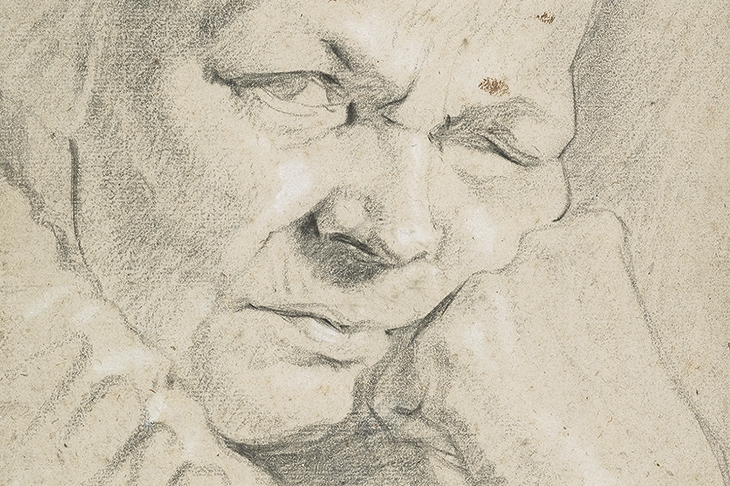Some art can be made in solitude, straight out of the artist’s head. But portraiture is a game for two. That’s the lesson of The Encounter: Drawings from Leonardo to Rembrandt, a marvellous little exhibition at the National Portrait Gallery. It is essentially a medley of Old Master works on papers from various British collections — which might sound a little on the quiet side. But that would be the wrong conclusion: on the contrary it poses intriguing questions and is full of visual pleasures.

‘Head of an Elderly Man
Wearing a Cap, probably Mino da Fiesole’ (c.1480–3) by Filippino Lippi
Notable in the latter category is a long row of Holbein’s studies of the early Tudor court and a striking array of works by Annibale Carracci and his school. But there is much else to pore over: these are often intimate works, which take you physically close to the marks of the artist’s hand. It’s worth peering to take in a tender little study by Filippino Lippi of a fellow artist, the sculptor Mino da Fiesole (c. 1480–3), or to examine a tiny Parmigianino profile of a little boy (c. 1535). But The Encounter also makes a serious point: any portrait is the record of a meeting between two people — which is why it is a complicated business.

‘Woman in a Netherlandish Headdress’ (c.1526-1528) by Hans Holbein the Younger
For one thing, a portrait may be affected not only by what the artist knows about art, but also by how well he or she knows the subject. One of the most touching in the show is Carlo Dolci’s red and black chalk study of his shoemaker (c. 1630). This tiny, careworn man with enormous ears is half smiling, as if chatting with the painter — as he probably was. Here is the record of a person, a moment and also a friendship.

‘The Artist’s Shoemaker’ (c.1630) by Carlo Dolci
A portrait documents a certain amount of time, and a drawing can do so faster than a painting, pinning down an instant. Thus, in about 1636 on the margin of a sheet of studies, Rembrandt jotted down the way his wife Saskia inclined her head, the way their baby nestled in her arms. There’s a huge amount of information in a few lines, probably taking much less than a minute to draw.

‘Giulio Pedrizzano’ (c.1593–4) by Annibale Carracci
Annibale Carracci’s study of his friend Giulio Pedrizzano (c. 1593–4), a lute player, could not have taken much longer. His pen was shooting over the paper, the sitter’s moustache, nostrils and eyes not much more than blots of ink. But the man’s proud, pensive, slightly quizzical presence is there.
It’s not hard to grasp what the artist brings to the process of portraiture: skill, observation, empathy. But how about the sitter? Well, without the subject, obviously there is nothing to investigate. Painters can depict people without models, but the results feel different — and often more repetitive. An invented face is very different from one that has been carefully contemplated.
The exhibition begins with some drawings that make this clear. These are not portraits, just made-up heads and bodies, pictures of nobody in particular. Many painters kept an image-bank of these on file. There’s a sheet of grimacing, bearded codgers on show from the workshop of Hans Holbein the Elder: useful staffage to fill in the jeering crowds behind martyred saints.

‘Study of a Young Man with his hands tied behind his back’ (c.1434-38) by Antonio Pisanello
To get a proper sense of verisimilitude, however, it is necessary to scrutinise a real person. There’s a beautiful demonstration of Pisanello (c. 1395–1455) doing just that around 1435. He planned to put a couple of corpses dangling from a gallows in the background of a fresco and had already sketched an actual hanged man. But he wanted more information about how the victim’s neck tilted and how his hands looked, tied together. So he got a lad, perhaps his apprentice, to pose as a stand-in for the cadaver. The result is a delicate portrayal of an early 15th-century teenage back, topped off with one of those pudding-basin haircuts worn by Henry V.
Leonardo’s ‘Study of a Nude Man’ (c. 1504–6) is similar: not a formal likeness, but a careful record of a particular body. With Pontormo’s ‘Study of a Nude Youth’ (c. 1523–4), in contrast, you don’t feel that so much. The pose, the figure bending over clutching a toddler, would have been impossible to hold for more than seconds. One wonders whether there was a model at all: the convoluted body and anxious round-eyed face seem to reveal more about Pontormo’s own dreams and neuroses (every painter, they used to say in the Renaissance, paints himself).

‘Seated Young Girl’ (1635) by Wenceslaus Hollar
In a true portrait the sitter is passive, but their presence, personality and appearance are crucial. Consciously or unconsciously, they are putting on a spectacle. They react to the observer, and the artist responds to them. That’s why the best of these drawings seem to condense a wordless relationship.

‘Man Wearing a Black Cap’ (c.1535) by Hans Holbein the Younger
We don’t know all that much about Hans Holbein the Younger from written documents. There are few surviving traces of his personality, no letters. But these drawings can tell us an amazing amount about his visual experiences. In the one of a young women who was possibly called Mary Zouch, c. 1533, you see what he noticed: her patient, averted gaze, blonde hair, and the set of her mouth, cautious but firm. You even seem to eavesdrop on him as he worked. The words ‘Black felbet’ (black velvet) are neatly noted in the middle of her bodice: a note from Holbein to himself, as if muttered in heavily accented English. When looking at it you feel you’ve met her, and in a way encountered him too.






Comments